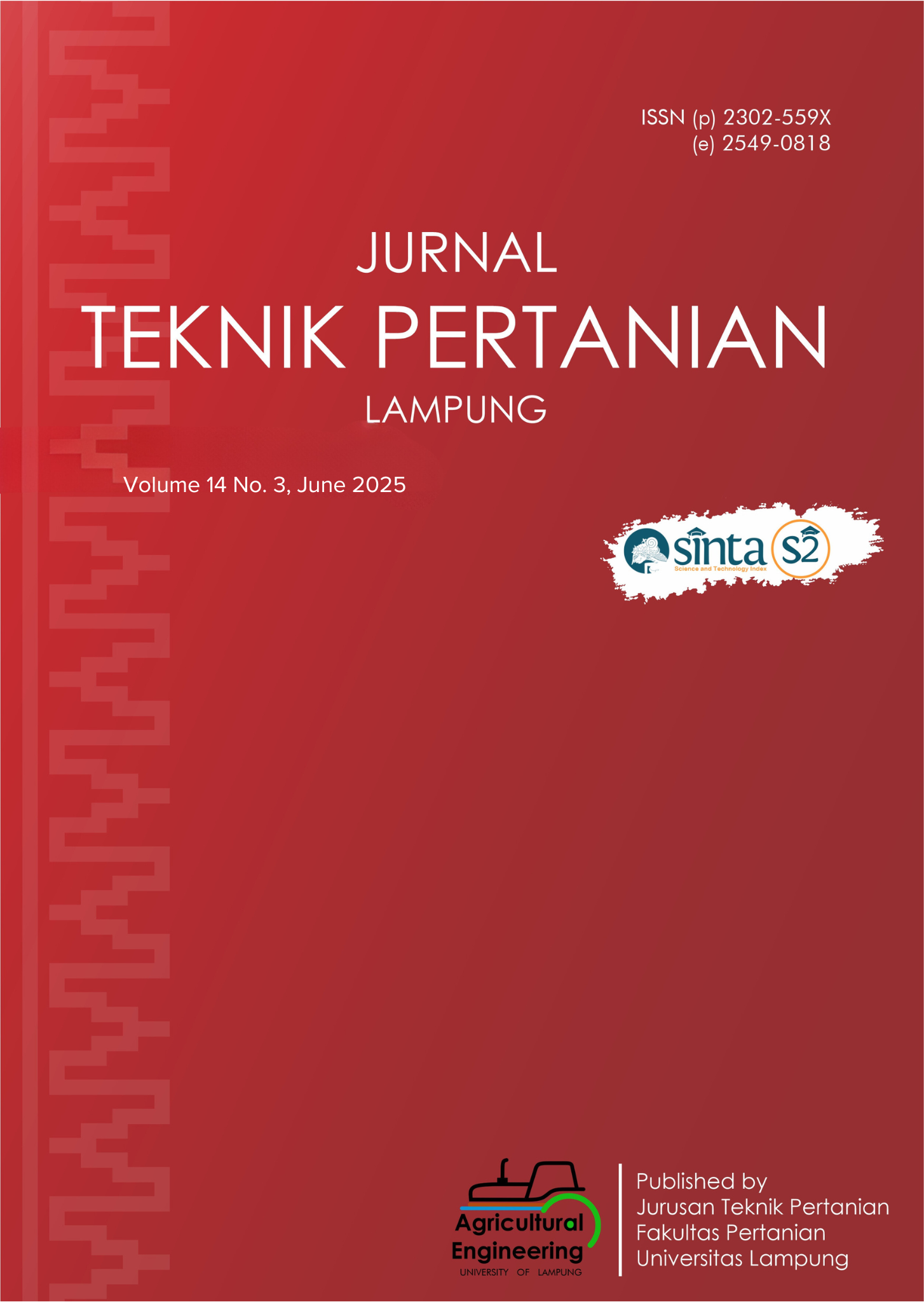Resistance of Streptomyces spp. Isolates towards Active Ingredients of the Nematicide Carbofuran and Dazomet, and its Effect on the Mortality of Nematodes Meloidogyne spp.
DOI:
https://doi.org/10.23960/jtep-l.v14i3.971-978 Abstract View: 111
Abstract View: 111
Abstract
The decrease in tomato plant production is caused by pest and disease attacks, one of which is the nematode Meloidogyne spp. Control measures still rely on synthetic nematicides, which can have negative effects on health, a broad spectrum of impact, microbial diversity, and resistance to attacks by Meloidogyne spp. Therefore, alternative control using biological agents that are resistant to the active ingredients of nematicides (carbofuran and dazomet) and have the ability to inhibit attacks by Meloidogyne spp. is needed. This study aims to test the resistance of Streptomyces spp. isolates to the active ingredients of synthetic nematicides, carbofuran and dazomet, and evaluate their effect on the mortality of Meloidogyne spp. nematodes. The method used is in vitro with the poisoned food technique and nematicidal activity testing against juvenile nematodes. The results show that the TMP isolate has better resistance than SP against carbofuran, with the second highest colony count of 11.47 × 10⁶ CFU/ml. Meanwhile, dazomet significantly inhibited the growth of Streptomyces spp. colonies. The mortality test showed that the TMP isolate was able to achieve a mortality rate of 59.01% in Meloidogyne spp. This proves the potential of Streptomyces spp. as a biological agent in nematode control and its resistance to nematicide residue active ingredients, making it an environmentally friendly alternative in agricultural practices.
Keywords: Biological agent, Carbofuran, Dazomet, Meloidogyne spp., Streptomyces spp.
Downloads
References
Atif, A.M., Elzamik, F.I., Mohamed, G.M., Al-Quwaie, D.A., Ashkan, M.F., Alqahtani, F.S., Motwali, E.A., Alomran, M.M., Alharbi, N.K., El-Tarabily, K.A., & Abdelbasit, H.M. (2023). Biological control of the root-knot nematode (Meloidogyne incognita) on eggplants with various chitinase-producing Streptomyces strains. European Journal of Plant Pathology, 167(3), 371-394. https://doi.org/10.1007/s10658-023-02718-8
Baćmaga, M., Wyszkowska, J., Borowik, A., & Kucharski, J. (2022). Effects of tebuconazole application on soil microbiota and enzymes. Molecules, 27(21), 7501. https://doi.org/10.3390/molecules27217501
Chen, Y.-Y., Tsay, T.-T., & Chen, P. (2024). Assessing the compatibility of streptomyces saraceticus with pesticides and the efficacy in controlling root‐knot nematode. Journal of Phytopathology, 172(5), e13385. https://doi.org/10.1111/jph.13385
Durahman, D. (2014). Eksplorasi nematoda parasit tumbuhan pada tanaman nilam (Pogostemon cablin Benth) di Kecamatan Kesamben Kabupaten Blitar. [Undergraduate Thesis], Brawijaya University.
Efendi, E., Mulyadisastra, S., & Giyanto. (2021). Potential of bacterial isolates from Peat Land as controlling agent for the root knot nematodes Meloidogyne incognita. Jurnal Fitopatologi Indonesia, 17(6), 243-250. http://dx.doi.org/10.14692/jfi.17.6.243-250
Fuentes, M.S., Briceño, G.E., Saez, J.M., Benimeli, C.S., Diez, M.C., & Amoroso, M.J. (2013). Enhanced removal of a pesticides mixture by single cultures and consortia of free and immobilized Streptomyces strains. BioMed Research International, 2013, 392573. https://doi.org/10.1155/2013/392573
Irmawatie, L., Robana, R., & Nuraidah, N. (2019). Ketahanan tujuh varietas tomat terhadap nematoda puru akar (Meloidogyne spp.). Agrotechnology Research Journal, 3(2), 61-68. http://dx.doi.org/10.20961/agrotechresj.v3i2.30392
Kaur, H., Singh, S., Rathore, Y.S., Sharma, A., Furukawa, K., Hohmann, S., Ashish., & Mondal, A.K. (2014). Differential role of HAMP-like linkers in regulating the functionality of the group III histidine kinase DhNik1p. Journal of Biological Chemistry, 289(29), 20245-20258. https://doi.org/10.1074/jbc.M114.554303
Liu, Y., Yang, X., Shen, W., Wang, X., Liu, H., Wang, Y., & Lu, H. (2024). Organophosphorus nematicide potentiated nematicidal effect by changing rhizosphere bacterial and fungal communities. Rhizosphere, 31(8), 100936. http://dx.doi.org/10.1016/j.rhisph.2024.100936
Mishra, S., Pang, S., Zhang, W., Lin, Z., Bhatt, P., & Chen, S. (2021). Insights into the microbial degradation and biochemical mechanisms of carbamates. Chemosphere, 279, 130500. https://doi.org/10.1016/j.chemosphere.2021.130500
Raihana, R., Fitriyanti, D., & Zairin, Z. (2019). Aplikasi perkembangan stadia hidup nematoda puru akar (Meloidogyne spp.) mulai dari fase telur sampai dewasa pada pertanaman tomat (Solanum lycopersicum L.) di Kota Banjarbaru. Agroekotek View, 1(2), 25-35. https://doi.org/10.20527/agtview.v1i2.682
Rajendran, K., Krishnamoorthy, M., Karuppiah, K., Ethiraj, K., & Sekar, S. 2024. Chitinase from Streptomyces mutabilis as an effective eco-friendly biocontrol agent. Applied Biochemistry and Biotechnology, 196(1), 18-31. https://doi.org/10.1007/s12010-023-04489-8
Rana, G.J., Momin, I.A., & Birari, U. (2019). Factors influencing the brand preference and farmers loyalty towards Bt cotton in Sabarkantha district. International Journal of Chemical Studies, 7(5), 111-115.
Shahid, M., Manoharadas, S., Chakdar, H., Alrefaei, A.F., Albeshr, M.F., & Almutairi, M.H. (2021). Biological toxicity assessment of carbamate pesticides using bacterial and plant bioassays: An in-vitro approach. Chemosphere, 278(11), 130372. http://dx.doi.org/10.1016/j.chemosphere.2021.130372
Soesetyaningsih, E., & Azizah, A. (2020). Akurasi perhitungan bakteri pada daging sapi menggunakan metode hitung cawan. Berkala sainstek, 8(3), 75-79. http://dx.doi.org/10.19184/bst.v8i3.16828
Suryaminarsih, P., Harijani, W. S., Muljani, I.R., Mindari, W., & Rahmadhini, N. (2020). Screening and identification of Actinomycetes produced chitinolytic from suppression soil as biological agents of fruit flies (Bactrocera sp.). Eurasian Journal of Biosciences, 14(1), 977.
Syahrok, S. F., Suryaminarsih, P., & Widiyati, W. (2021). Potensi Trichoderma sp. dan Streptomyces sp. sebagai agensia hayati nematoda puru akar (Meloidogyne sp.) pada tanaman tomat ceri secara in vitro. Agrista: Jurnal Ilmiah Mahasiswa Agribisnis UNS, 5(1), 1199-1206.
Tondon, S.A., Deore, R., & Parab, A. (2018). Isolation, identification and the use of carbofuran degrading microorganisms for the removal of carbofuran pesticide from contaminated waters. Global Journal of Bio-Science and Biotechnology, 6(1), 89-95.
Zhu, F., Xiao, J., Zhang, Y., Wei, L., & Liang, Z. (2020). Dazomet application suppressed watermelon wilt by the altered soil microbial community. Scientific Reports, 10(1), 21668. https://www.nature.com/articles/s41598-020-78839-5
Wang, Y., Jin, Y., Han, P., Hao, J., Pan, H., & Liu, J. (2021). Impact of soil disinfestation on fungal and bacterial communities in soil with cucumber cultivation. Frontiers in Microbiology, 12, 685111. https://doi.org/10.3389/fmicb.2021.685111
Wu, R., Li, Y., Meng, J., & Han, J. (2025). Effects of dazomet fumigation combined with Trichoderma harzianum on soil microbial community structure of continuously cropped strawberry. Horticulturae, 11(1), 35. https://doi.org/10.3390/horticulturae 11010035
Downloads
Published
How to Cite
Issue
Section
License
Authors who publish with this journal agree to the following terms:
Authors retain copyright and grant the journal right of first publication with the work simultaneously licensed under a Creative Commons Attribution-ShareAlike 4.0 International Lice that allows others to share the work with an acknowledgement of the work's authorship and initial publication in this journal.
Authors are able to enter into separate, additional contractual arrangements for the non-exclusive distribution of the journal's published version of the work (e.g., post it to an institutional repository or publish it in a book), with an acknowledgement of its initial publication in this journal.
Authors are permitted and encouraged to post their work online (e.g., in institutional repositories or on their website) prior to and during the submission process, as it can lead to productive exchanges, as well as earlier and greater citation of published work (See The Effect of Open Access).
Jurnal Teknik Pertanian Lampung

JTEPL is licensed under a Creative Commons Attribution-ShareAlike 4.0 International License.













